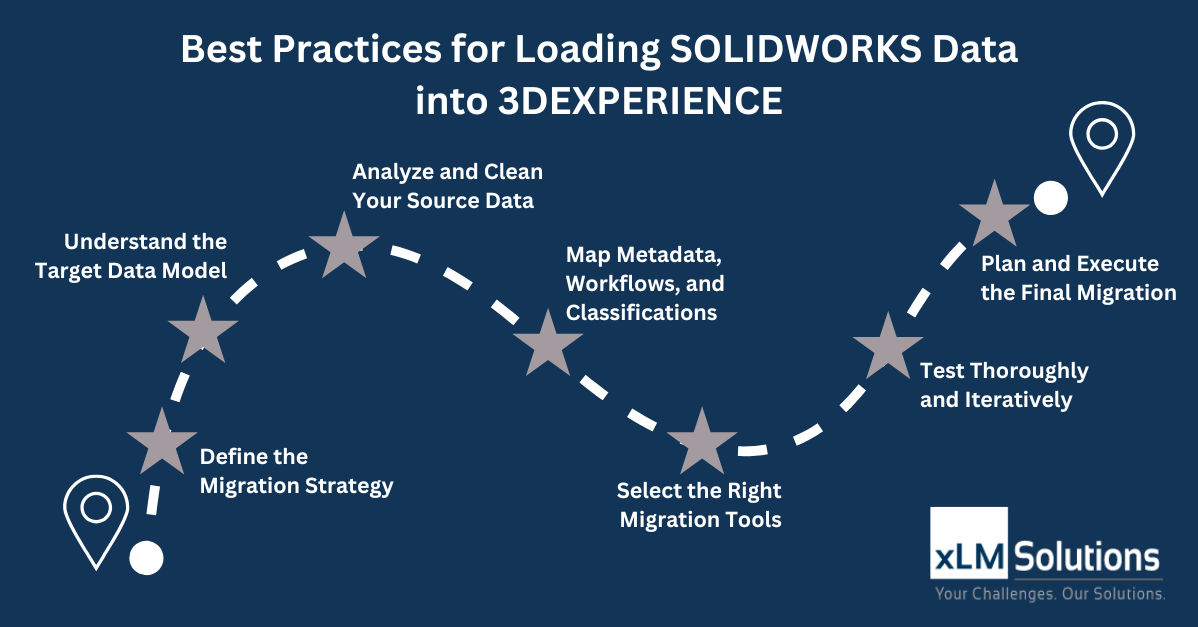At xLM Solutions, we’ve supported companies of all sizes through complex migrations ofSOLIDWORKS data to 3DEXPERIENCE. Whether you’re moving data from legacy PDM systems or local network folders – whether on cloud or premise– the key to success is a well-thought-out strategy grounded in real-world experience.
In our recent webinar, Best Practices for Loading SOLIDWORKS Data into 3DEXPERIENCE, my colleague Ilan Madjar and I shared practical insights to help SOLIDWORKS / 3DEXPERIENCE (click link to watch) admins, engineering managers, and implementation teams migrate SOLIDWORKS data right the first time.
Here’s a recap of what we covered.
Why Planning Matters
Loading SOLIDWORKS data into 3DEXPERIENCE isn’t just about moving files – it’s about aligning your CAD structure with the 3DEXPERIENCE Unified Product Structure (UPS) data model. Before you start we recommend you to:
- Understand how UPS works, especially the mapping of configurations to Physical Products
- Clarify why you’re migrating. What are the benefits you are looking to obtain from managing SOLIDWORKS data in 3DX such as – improving efficiency, enabling collaboration, or supporting digital transformation?
- Define the scope: all revisions vs. latest only? Released + in-work?
The most successful migrations begin with strong discovery workshops and detailed mapping sessions. Rushing this step leads to costly rework.
Preparing and Cleaning Your Data
Every migration should start with a data quality audit. You’ll want to:
- Check and clean up/fix duplicate filenames and/or part numbers
- Validate revision history and ensure it conforms to your 3DEXPERIENCE patterns
- Confirm proper file references (especially for assemblies and linked parts)
- Identify missing or incorrect meta data (descriptions, owners, etc.)
Bad data in = bad data out. If needed, we also have tools to help identify and fix these problems early, preventing issues later during import.
Tools for Every Scenario
Depending on your environment, here are the tools we recommend:
✅ Manual or Batch Save
- Best for folder-based data
- Simple to use via the SOLIDWORKS Connector
✅ EDAT (ENOVIA Development Acceleration Toolkit)
- Ideal for large on-premise migrations
- Supports full revision history, complex mappings, and orchestration
✅ XTA (3DEXPERIENCE Transition Assistant)
- Purpose-built for cloud migrations
- Supports delta loads, full history, and advanced mappings
✅ XPDM and EIF
- For non-Dassault systems like Teamcenter or Windchill
- Allows you to transform and import data via STEP X or XPDM XML formats
We covered tradeoffs between each, including licensing, supported CAD types, and when to use post-processing (e.g., for STEP file generation or derived outputs).
Testing and Going Live
In our opinion, testing is the most important step which gets overlooked in many migrations.
No migration is perfect the first time.
You’ll need multiple test cycles – each with a structured test plan – to:
- Validate revisions/versions, file references, and meta data
- Simulate real-world workflows scenarios, create new revisions of data, revise data via SOLIDWORKS Connector, and put such data through change actions
- Test with all size assemblies, make sure no performance issues on large assemblies and test with both new and migrated data in the assembly
- Identify issues, fix and re-migrate,test and validate issues have been resolved
We recommend running 2–4 full test migrations before go-live, and documenting every step of the process. This ensures your final cutover – ideally done over a weekend – goes smoothly.
How xLM Can Help
xLM Solutions is more than just a service provider—we’re a trusted partner with deep expertise in both SOLIDWORKS and 3DEXPERIENCE. Here’s how we help:
- Planning & Strategy: We guide you through early decisions around data scope, UPS alignment, and tooling—based on what’s best for your environment.
- Custom Mapping & Cleanup: From classification and metadata rules to revision schemes, we help ensure your data is clean, compliant, and ready for import.
- Tool Selection & Execution: We’ve implemented migrations using every major method – from Dassault-provided tools to custom integrations – and can recommend the best fit for your needs.
- End-to-End Support: We stay engaged through every phase: discovery, testing, validation, go-live, and post-launch. We also offer custom tools to streamline your processes and improve productivity.
No matter how complex your environment is, we can help you migrate with confidence – and get real value from 3DEXPERIENCE faster.
Watch the webinar on-demand to learn more and please get in touch with our team if you have any questions.

